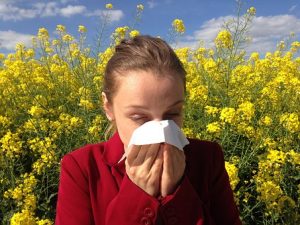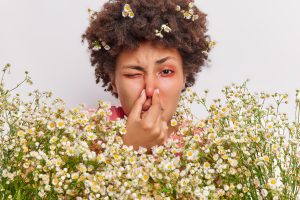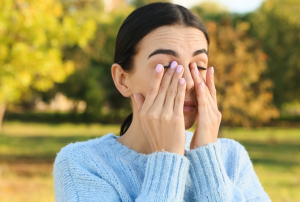With the arrival of spring, many of us look forward to the awakening of nature and the return of warmer, brighter days. However, for some this season also brings with it annoying eye disorders, such as keratoconjunctivitis Vernal, which can turn the joy of spring into a real nightmare.
What characterises keratoconjunctivitis Vernal
 Vernal keratoconjunctivitis is a form of allergic conjunctivitis that usually occurs during the spring season and is characterised by an inflammation of the conjunctiva, the membrane that covers the sclera and the inside of the eyelids.
Vernal keratoconjunctivitis is a form of allergic conjunctivitis that usually occurs during the spring season and is characterised by an inflammation of the conjunctiva, the membrane that covers the sclera and the inside of the eyelids.
This is an allergic reaction to pollen and other allergens in the environment.
Epidemiology and Risk Groups
Vernal keratoconjunctivitis mainly affects young males, with a higher incidence between the ages of 5 and 20.
 Epidemiological studies have shown that this condition is more common in hot, dry climates. In addition, children with a family history of allergies are more likely to develop this form of conjunctivitis.
Epidemiological studies have shown that this condition is more common in hot, dry climates. In addition, children with a family history of allergies are more likely to develop this form of conjunctivitis.
Interestingly, the prevalence is higher in the Mediterranean, African and Middle Eastern regions. This suggests that environmental and genetic factors play a significant role.
Key Elements:
- Genetic predisposition: family history of allergies.
- Climate: most common in hot, dry climates.
- Age: highest incidence between 5 and 20 years.
Knowing the risk groups can help in early diagnosis and effective management of symptoms.
Symptoms of keratoconjunctivitis Vernal
The symptoms of Vernal keratoconjunctivitis can vary from mild to severe, affecting the quality of life of affected individuals. Managing symptoms is crucial to prevent complications and improve quality of life.
Ocular signs and symptoms
Common ocular symptoms of keratoconjunctivitis Vernal include intense itching, redness and tearing.
Other symptoms may be photophobia, a foreign body sensation in the eye and mucous secretion. This secretion can form a film that accumulates during the night, making it difficult to open the eyes in the morning.
One of the distinctive clinical signs is the presence of giant papillae on the tarsal conjunctiva, which can be observed during an eye examination.
Steps for recognising symptoms:
- Observe the presence of itching and redness.
- Check lacrimation and secretion.
- Seek medical advice if symptoms persist.
Accurate identification of symptoms helps to ensure timely and appropriate treatment.
Associated Systemic Symptoms
Although keratoconjunctivitis Vernal is primarily an ocular problem, it may be accompanied by systemic symptoms, such as sneezing and nasal congestion. These symptoms are common in people with other allergic conditions, such as allergic rhinitis.
In some cases, patients may experience fatigue and irritability due to persistent eye discomfort.
Diagnosis of Conjunctivitis Vernal
Diagnosing Vernal keratoconjunctivitis requires a detailed eye examination and sometimes additional tests to differentiate it from other eye conditions.
Clinical Examinations and Instruments
The diagnosis of Vernal keratoconjunctivitis is primarily based on a comprehensive eye examination. The ophthalmologist may use a slit lamp to examine the conjunctiva and identify giant papillae or signs of inflammation.
In some cases, allergy testing may be necessary to identify the specific allergens responsible for the reaction.
Diagnostic process:
- Slit-lamp examination.
- Assessment of clinical history and symptoms.
- Possible allergy test for confirmation.
An accurate diagnosis is essential to plan an effective and customised treatment.
Differentiation from Other Pathologies
It is crucial to differentiate keratoconjunctivitis Vernal from other eye diseases, such as bacterial or viral conjunctivitis. Distinguishing features include the seasonal nature of symptoms and the presence of giant papillae.
Misdiagnosis can lead to inappropriate treatment, worsening symptoms.
Comparison:
| Feature | Keratoconjunctivitis Vernal | Bacterial conjunctivitis |
|---|---|---|
| Seasonality | Spring | Non-seasonal |
| Main symptoms | Itching, giant papillae | Purulent secretion |
| Treatment | Antihistamines | Antibiotics |
Distinguishing the conditions correctly helps to avoid complications and improve the patient's quality of life.
Available Treatments
Once Vernal keratoconjunctivitis has been diagnosed, it is important to adopt an effective treatment plan. In this section, we will discuss available pharmacological options and natural remedies that can help prevent and manage symptoms.
Pharmacological options
Pharmacological treatments for Vernal keratoconjunctivitis include the use of antihistamines and mast cell-stabilising eye drops. These drugs help reduce inflammation and relieve symptoms.
In more severe cases, topical corticosteroids may be prescribed for a short period. However, prolonged use of steroids can cause side effects, so it is important to follow the doctor's instructions.
Common drugs:
- Oral antihistamines: to reduce itching and inflammation.
- Mast cell stabilisers: to prevent histamine release.
- Corticosteroids: for short-term treatment of severe symptoms.
Appropriate treatment can significantly improve quality of life during the spring season.
Natural Remedies and Prevention
 In addition to drug treatments, there are natural remedies that can help manage the symptoms of Vernal keratoconjunctivitis. For instance, applying cold compresses to the eyes can reduce swelling and provide relief from itching.
In addition to drug treatments, there are natural remedies that can help manage the symptoms of Vernal keratoconjunctivitis. For instance, applying cold compresses to the eyes can reduce swelling and provide relief from itching.
It is also useful to wear sunglasses to protect the eyes from exposure to pollen and other allergens.
Avoiding rubbing the eyes can prevent further irritation.
Practical advice:
- Use cold compresses to relieve symptoms.
- Wear sunglasses outdoors.
- Avoid rubbing the eyes.
These practices, together with medical treatments, can help maintain comfort during spring.
Tips for a Peaceful Spring
To experience a peaceful spring despite Vernal keratoconjunctivitis, it is essential to effectively manage daily symptoms and make some lifestyle changes.
Management of Daily Symptoms
 Managing the daily symptoms of Vernal keratoconjunctivitis is essential for maintaining a good quality of life. An eye care routine can include regular use of prescribed eye drops and the application of cold compresses as needed.
Managing the daily symptoms of Vernal keratoconjunctivitis is essential for maintaining a good quality of life. An eye care routine can include regular use of prescribed eye drops and the application of cold compresses as needed.
It is important to maintain good eye hygiene by washing your hands regularly and avoiding touching or rubbing your eyes.
Steps for daily management:
- Apply eye drops as prescribed.
- Use cold compresses for immediate relief.
- Avoid touching the eyes with dirty hands.
By following these tips, you can reduce discomfort and enjoy spring without worries.
Tips for Everyday Life
To reduce exposure to allergens, it is advisable to keep windows closed during windy days and use an air purifier in the home. In addition, wearing wide-brimmed hats can further protect the eyes.
It is also useful to plan outdoor activities when pollen levels are lower, such as early in the morning or after a rain shower.
Practical Tips:
- Use air purifiers to reduce the presence of allergens in the home.
- Wear a wide-brimmed hat outdoors.
- Plan outings at times of lowest pollen concentration.
These tips can help reduce pollen exposure and improve comfort during the spring season.
See also:
- Allergic conjunctivitis and gut microbiota - Oculista Italiano
- Eye allergies: a problem for all seasons - Oculista Italiano
Hehar NK, Chigbu DI. Vernal Keratoconjunctivitis: Immunopathological Insights and Therapeutic Applications of Immunomodulators. Life (Basel). 2024 Mar 9;14(3):361. doi: 10.3390/life14030361. PMID: 38541686; PMCID: PMC10971875.
